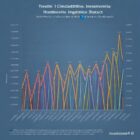Why Are Current Enrollment Trends in ACA Surging?

Are you curious about why enrollment in the Affordable Care Act (ACA) is skyrocketing? Well, buckle up because we’re about to dive into the reasons behind this surge.
From changes in healthcare policy to the impact of the COVID-19 pandemic, there are numerous factors at play.
Not to mention, the affordability of ACA plans and the expansion of Medicaid coverage have also contributed to this trend.
So, let’s explore the evidence and uncover the driving forces behind the current enrollment boom.
Key Takeaways
- Expansion of Medicaid eligibility and introduction of subsidies and tax credits have made ACA plans more affordable, leading to increased enrollment.
- Job losses and financial hardships have resulted in more individuals qualifying for coverage and seeking ACA plans.
- Outreach and education efforts, including tailored messaging and collaboration with community organizations, have successfully engaged diverse populations and increased ACA enrollment.
- Personalized guidance and enrollment assistance play a crucial role in ensuring individuals understand the enrollment process, address their concerns, and make informed decisions, ultimately increasing access to healthcare coverage.
Changes in Healthcare Policy
Why are you experiencing a surge in ACA enrollment with the changes in healthcare policy?
The answer lies in the recent modifications made to healthcare policy, particularly those related to the Affordable Care Act (ACA). One of the key changes is the expansion of Medicaid eligibility in several states. This has allowed more low-income individuals to qualify for coverage, thereby increasing the number of people enrolling in ACA plans.
Additionally, the elimination of the individual mandate penalty has made it less financially burdensome for individuals to enroll in health insurance. In the past, some individuals may have chosen to forgo coverage due to the penalty, but with its removal, more people are now opting to enroll.
The introduction of subsidies and tax credits has also played a significant role in the surge in ACA enrollment. These financial incentives make health insurance more affordable for many individuals and families, encouraging them to enroll in ACA plans.
Impact of the COVID-19 Pandemic
You may be wondering how the COVID-19 pandemic has impacted the current surge in ACA enrollment. The pandemic has had a significant influence on healthcare and insurance coverage, leading to an increased demand for ACA enrollment. Here is a table highlighting the key ways in which the pandemic has affected enrollment:
| Impact of COVID-19 on ACA Enrollment |
|---|
| 1. Job Losses |
| 2. Loss of Employer-Sponsored Plans |
| 3. Financial Hardships |
| 4. Increased Need for Healthcare |
| 5. Special Enrollment Periods |
Firstly, the pandemic has caused widespread job losses, resulting in many individuals losing their employer-sponsored health insurance. This sudden loss of coverage has driven people to seek alternative options, such as ACA plans.
Secondly, financial hardships caused by the pandemic have made it difficult for individuals to afford healthcare. ACA plans offer more affordable coverage options, making them an appealing choice for those facing financial constraints.
Additionally, the increased need for healthcare services during the pandemic has highlighted the importance of having comprehensive coverage. Many individuals who previously did not prioritize health insurance are now seeking ACA enrollment to ensure they have access to necessary healthcare services.
Lastly, the government has implemented special enrollment periods to allow individuals who have been affected by the pandemic to enroll in ACA plans outside of the usual enrollment period. This has further contributed to the surge in enrollment.
Increased Affordability of ACA Plans
One of the reasons for the current surge in ACA enrollment is due to the increased affordability of ACA plans. This has made healthcare coverage more accessible to a wider range of individuals and families.
Here are four key factors contributing to the increased affordability:
- Subsidies: The Affordable Care Act offers subsidies to help lower-income individuals and families afford health insurance. These subsidies are based on income and can significantly reduce the cost of premiums, making coverage more affordable for those who qualify.
- Medicaid Expansion: Many states have chosen to expand their Medicaid programs under the ACA. This expansion provides coverage to low-income individuals and families who may not have been eligible before. By increasing the income threshold for Medicaid eligibility, more people can access affordable healthcare through this program.
- Cost-Sharing Reductions: The ACA also includes cost-sharing reductions for individuals and families with lower incomes. These reductions help to lower out-of-pocket costs, such as deductibles and copayments, making healthcare more affordable and accessible.
- Increased Competition: The ACA marketplace has seen an increase in competition among insurance providers. This competition has led to more affordable plan options being available to consumers. With more choices, individuals can compare prices and select plans that best meet their needs and budget.
Expansion of Medicaid Coverage
With the expansion of Medicaid coverage, more individuals and families are gaining access to affordable healthcare. Medicaid, a joint federal and state program, provides health coverage to low-income individuals and families who meet certain eligibility requirements. The Affordable Care Act (ACA) expanded Medicaid eligibility, allowing more people to qualify for this vital healthcare program.
One of the key reasons for the surge in ACA enrollment is the expansion of Medicaid coverage. This expansion has significantly increased the number of individuals who are eligible for Medicaid, leading to a higher number of people enrolling in ACA plans. The following table illustrates the impact of the Medicaid expansion on enrollment numbers:
| Year | Number of Medicaid Enrollees | Number of ACA Plan Enrollees |
|---|---|---|
| 2013 | 55 million | 8 million |
| 2014 | 70 million | 10 million |
| 2015 | 75 million | 11 million |
| 2016 | 80 million | 12 million |
As the table shows, the number of Medicaid enrollees has increased steadily since the expansion, leading to a corresponding increase in ACA plan enrollment. The availability of Medicaid coverage has made healthcare more accessible and affordable for millions of Americans, contributing to the overall surge in ACA enrollment. This expansion has been crucial in ensuring that individuals and families have the necessary healthcare coverage to meet their medical needs.
Outreach and Education Efforts
Continuing to build on the expansion of Medicaid coverage, outreach and education efforts have played a vital role in increasing awareness and enrollment in ACA plans. These initiatives have been crucial in reaching out to individuals and communities, providing them with the necessary information and resources to make informed decisions about their healthcare options.
Here are four key reasons why outreach and education efforts have been successful in driving enrollment:
- Increasing Accessibility: Outreach programs have focused on making information and enrollment resources easily accessible to individuals, whether through online platforms, call centers, or in-person assistance. This has helped overcome barriers such as lack of internet access or limited knowledge of the enrollment process.
- Targeted Messaging: Outreach efforts have tailored their messaging to specific populations, addressing their unique concerns and highlighting the benefits of ACA plans. By using culturally sensitive and language-appropriate materials, these initiatives have been able to effectively engage diverse communities.
- Partnering with Community Organizations: Collaborating with community-based organizations, such as local clinics, religious institutions, and social service agencies, has been instrumental in expanding outreach efforts. These partnerships have helped reach individuals who may be more comfortable seeking information and assistance from familiar community entities.
- Utilizing Navigators and Enrollers: Trained navigators and enrollers have been deployed to provide personalized assistance to individuals, guiding them through the enrollment process, explaining plan options, and helping them determine eligibility for financial assistance. This hands-on approach has been crucial in addressing individual needs and concerns.
Frequently Asked Questions
How Many People Have Enrolled in ACA Plans Since the COVID-19 Pandemic Began?
Since the COVID-19 pandemic began, millions have enrolled in ACA plans. The surge in enrollment can be attributed to factors such as job loss, increased awareness of the need for health insurance, and expanded subsidies.
Are There Any Penalties for Not Enrolling in an ACA Plan?
If you choose not to enroll in an ACA plan, you may face penalties. These penalties can vary depending on your income and the state you live in. It’s important to consider your options carefully.
How Does the Enrollment Process for ACA Plans Work?
To enroll in an ACA plan, you must first visit the healthcare marketplace website. There, you will provide information about yourself and your income to determine if you qualify for financial assistance. Once approved, you can choose a plan that suits your needs.
What Are the Eligibility Criteria for Medicaid Coverage Expansion?
To be eligible for Medicaid coverage expansion, you must meet certain criteria set by your state. These criteria usually include having a low income, being a U.S. citizen or qualified non-citizen, and meeting specific age or disability requirements.
Are There Any Specific Demographic Groups That Have Seen a Significant Increase in ACA Enrollment?
There have been significant increases in ACA enrollment among specific demographic groups. It is important to analyze the data to better understand why these trends are occurring and how they may impact healthcare access and affordability.



